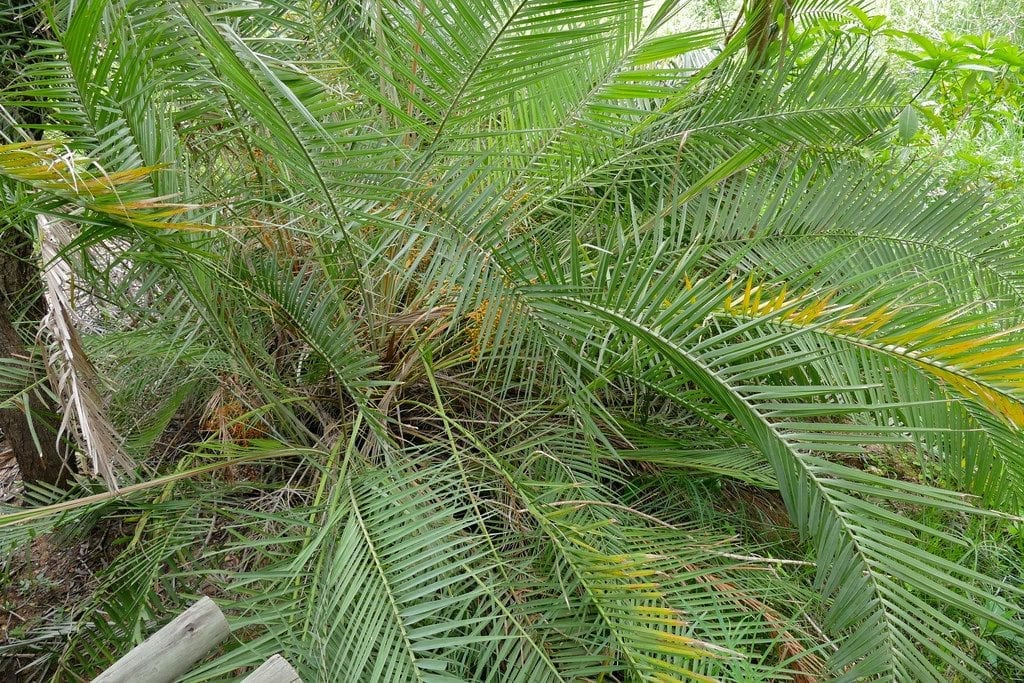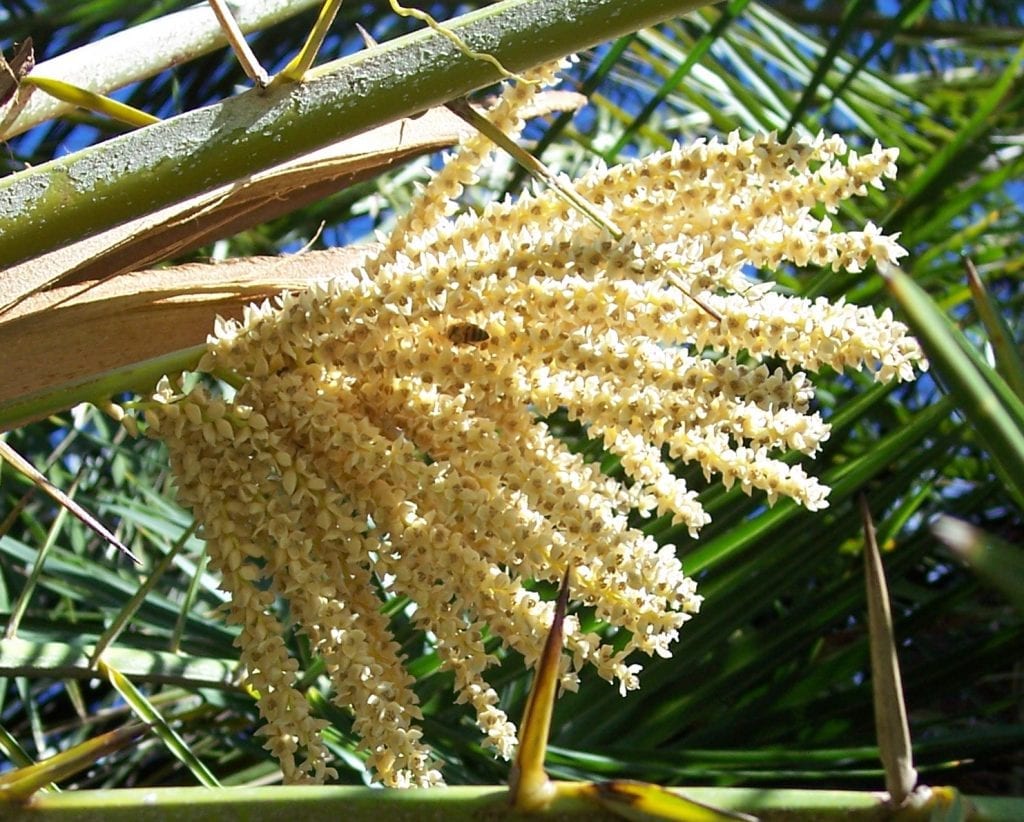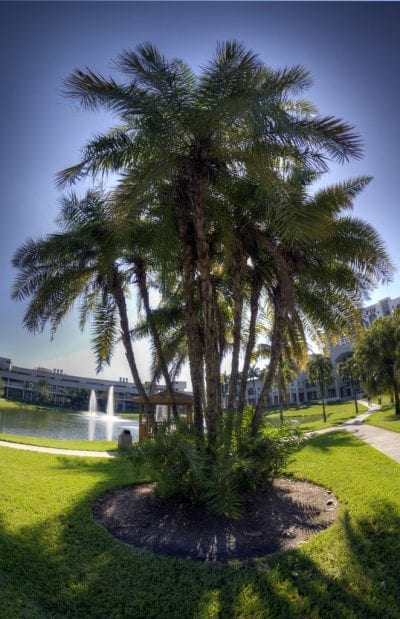
La Phoenix reclines It is one of my favorite multi-stemmed palm trees, and you may easily notice that as you read this article. Its elegance can be compared to that of the Cocos nucifera (coconut tree), saving the distances that yes, since they are two totally different species.
Therefore, it is not a plant that, in theory, can be grown in pots for a long time or in small gardens since it needs a lot of space to grow. Now, and I repeat, this is the theory. The reality is that those suckers that are coming out can be removed so that it has a single trunk, and as this one is also thin because ... 😉 Do you want to meet her?
Origin and characteristics

Our protagonist is a palm native to the tropics of Africa, the Arabian Peninsula and the Comoros Islands whose scientific name is Phoenix reclinesAlthough it is popularly known as the Senegal palm or reclining palm. As I anticipated, is multicaule, producing stems up to 15 meters high by 30cm wide. The leaves are pinnate and curved, with a length of 2,5 to 4,5m by about 0,75cm wide. These are green in color, either bright or deep green, and are made up of 30cm petioles armed with long, sharp spines at the base. The crown has 20-40 leaves.
It is a dioecious plant, which means that there are female and male feet. The male inflorescences are pale yellow, while the female ones are small, globose and yellow-green. The fruit is about 2,5cm in diameter, is orange and edible. This one inside contains a single seed that is very reminiscent of the one in the date box but is a little thicker and larger.
It has to be said that all palms of the genus Phoenix hybridize very easily, resulting in variations naturally. So if you want one Phoenix reclines 'pure' you must make sure that the characteristics more or less coincide with those that I have mentioned above (obviously, the height, the number and the length of the leaves cannot coincide because nobody sells such adult palm trees, and also, it is Hard to find them in the gardens, which is a real shame).
What are their cares?

If you want to have a copy, we recommend that you provide it with the following care:
Location
In order for it to grow well, with its multiple trunks, it is important that it be in a wide space, at least 4 meters long and another 4m wide. Of course, it has to be outside, in full sun. It is necessary to give it the light of the king star if possible throughout the day, as it does not tolerate semi-shadow, much less shadow.
Earth
- Garden: grows in all types of soils, but prefers those with good drainage.
- Flower pot: It is not a plant to have in a pot for a long time, but while it is young it can be had in one with a universal growing substrate mixed with 30% perlite. You can get the first here and the second here.
Irrigation
It is a palm tree that resists drought well, but if it is grown in a pot or in a particularly dry area (such as the warm Mediterranean) it must be watered from time to time. To give you more or less an idea of how much to water it, here you go:
- Flower pot: 3 times a week in summer and every 5-6 days the rest of the year.
- Garden: during the first year about twice a week; From the second onwards, the risks can be spread out. If they fall a minimum of 350-400mm / year after the third year, it will not matter to water it -although you will appreciate it from time to time 😉 -.
Multiplication

It is one of the few that they can be multiplied both by seeds and by division of suckers, in spring. Let's see how to proceed in each case:
Seeds
- The first thing to do is clean them and place them in a glass of water for 24 hours.
- The next day, a pot measuring 10,5cm in diameter is filled with universal growing medium and watered.
- Then, 2-3 seeds are placed on the surface, and they are covered with a thin layer of substrate so that they are not exposed to the sun.
- Finally, it is watered again and the pot is placed outside, in full sun.
Will germinate in 1-2 months at a temperature of about 25ºC.
Young
It's complicated but not impossible. To do this, select a sucker that has an easily manipulable size, cut it as much as possible from the mother's trunk, impregnate the base with homemade rooting agents and plant it in a pot with vermiculite (you can get it here) previously moistened.
Keeping the substrate moist, and the pot outside in semi-shade, the plant will take root after 2 to 3 weeks.
Pruning
It's not necesary. Only dry, diseased or weak leaves need to be removed at the end of winter. You can also remove the suckers if you do not want it to have or not have as many, at the beginning of spring.
Plagues and diseases
It is very, very resistant, but like all palm trees, and especially those of its genus Phoenix, it is vulnerable to attack by Red weevil y paysandisia archon. If you live in an area where these pests already exist, or where there is a risk of them (it does not matter if it is low), you have to do preventive treatments with imidacloprid or with these Remedies.
The symptoms are:
- Fibers coming out of the trunk
- Center leaf deviated
- Fan-shaped holes in the leaves
- Holes in the trunk
- Yellowing and rapid death of leaves
- Weakening
- It could flourish in an attempt to leave a new generation before dying
Rusticity
Resists up to -7ºC.

What did you think of Phoenix reclines?